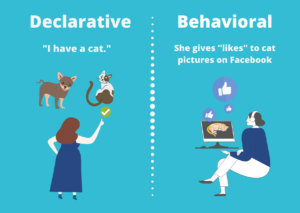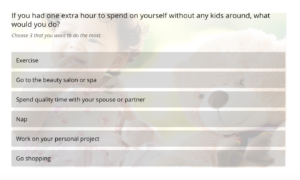What is the ultimate goal for most businesses? Selling the right products to the people who want them the most. As customers grow more aware of the value of their data, organizations are driven to obtain high-value consumer data without tampering with consumer privacy. Utilizing declarative data, part of an Ethically Gathered Data strategy, is a way that customers can directly communicate with brands.
What is Declarative Data?
Declarative data, also called zero party data, is essentially self-reported data collected from consumers voluntarily. Declarative data comes straight from the source of the customers, without the need for inferences or guessing. So what you see is what you’ll get. For brand marketers and researchers, declarative data is rather efficient for consumer behavior analysis, finding out what triggers buying behaviors and precision targeting. Furthermore, declarative data is useful not only for marketing purposes but also for helping people from all the industries better understand their customers, optimize product experiences, and prioritize business strategy.
How is Declarative Data Different from Behavioral Data?
Declarative data and behavioral data differ in the data collection process. As we can see in the below illustration, declarative data comes from customers, and they share with the brands what they think and what they want.

On the other hand, behavioral data comes from observing customer behaviors such as media consumption, social media listening, digital footprint tracking, sentiment analysis and so on, without their direct feedback.
Why Use Declarative Data?
To construct personalized brand experiences, gathering effective customer insights plays a crucial role. Why not let the customers tell you what they want, what they really, really want? Here are the main applications of collecting declarative data:
Consumer Understanding Collecting timely, honest insights directly from consumer self-reporting can steer your strategy towards the optimal product, brand claim, customized services and so forth.
Customer Experience Customer experiences are grounded in emotion and often cannot accurately be inferred. Optimal measurement of satisfaction levels and customer experience measurements is best done through proactive, declarative data experiences. Feedback collected directly from relevant customers outlines the features, services or design they truly desire, helping brands continually craft better experiences.
Marketing Personalization Brands can better market to consumers by simply asking the questions they want to know most. Designing a strategy based on declarative data that can resonate with consumer beliefs and personalities will facilitate a real connection with your audience, and build true long term retention and loyalty.
Use Cases
Segmanta’s solutions enable question flows that are designed for the respondents to have a “conversational” experience while simultaneously providing the user with deep insights. Below are some of survey examples and use cases of how declarative data can be collected:
Net Promoter Score® (NPS) Ask customers how likely they would recommend your brand to others as a measurement of satisfaction and loyalty. Among the responses you receive, you’ll identify the promoters of your brand, your most loyal customers who you want to empower. After all, loyal customers are the best salespeople. You can see our template here.

Seed Audience Builder Building the correct seed audience is the foundation of effective marketing. Segmanta empowers brands to collect declarative data that reflects the respondents’ preferences via highly engaging survey options and logical structure. Marketers are able to retrieve valuable feedback directly from the customers. Further, Segmanta supports various data integration options for the decision-makers to pipe in the research results to marketing data platforms. This way, to form the data-enriched, personalized audience strategy will be more impactful.
Consumer insights This is a great way to find out your target audience’s attitudes and preferences when it comes to a specific topic or attribute. In the below example, we asked new moms from 9 Asian geographic regions how they would rate the impact of motherhood on their social life. The result indicated motherhood has an overall positive impact on social life in their opinion.

Brand awareness In The Big Snacks Survey, we helped brands uncover snacking habits of Generation Z, we thought it would be valuable to see how Gen Zers associate snacking with certain snack items. It turned out, the majority claimed “chips” are the first thing that came to mind. This insight helped the marketers understand that chips are highly likely to be Gen Zers’ go-to snack compared to other snack categories, and this insight cannot be obtained simply from the audience’s obvious social media usage or online behaviors accurately. You can see the results here.

“If you had one extra hour to spend on yourself without any kids around, what would you do?”
In our Moms in Asia 2020 Survey, we asked what the mothers would prefer to do if given one extra hour per day without motherly duties. Except for the obvious need to get more rest, moms declared they want to spend quality time with their partners and treat themselves to a beauty salon trip amongst other choices. With this analysis, we understand that mothers wish for expressing their identity as a loving partner and getting some well-deserved self-care. You can see the results here.

How to optimize collected Declarative Data with Segmanta
Set your goal Before you start constructing a survey, list out the desired outcomes or insights goals, and whether the audience would be willing to disclose this data. Planning the survey outline and anticipated insights in advance saves a great amount of time and effort.
Visually appealing design Segmanta offers survey design tools that are visual-first and customizable to build appealing survey experiences that are brand-focused. Segmanta also provides a quiz builder, making the data collection process fun and engaging for your respondents. As a result of this, the consumers will feel motivated to share declarative data with your brand.
Ask the right questions in the right format Survey questions should aim to solve your most pressing challenges in consumer understanding, customer experience or personalized marketing. Beware of how you communicate with your audience; using easy-going, approachable language to make the respondents answer the questions will make the questions feel less intrusive. Additionally, take advantage of the abundant choice of question types in Segmanta’s survey builder to make the survey fun and engaging. Furthermore, the analytics of the results will have a comprehensive visualization layout thanks to the diverse question types.
Ask the relevant questions to the relevant respondents Create a question logic flow that will show only the relevant questions to the relevant respondents based on their previous survey answers, so that your insights are accurate and consistent.
Ask a reasonable amount of questions Controlling the number of questions in the survey is crucial to ensure a good completion rate. Identifying potential drop-offs and consider adjusting question type or phrasing to avoid a high bounce rate.
Harvest valuable insights using smart segmentation and integrations With a well-arranged survey as a foundation, extracting insights and personalizing your marketing will be extremely valuable for your business decisions. In Segmanta’s analytics dashboard, you can slice and dice the survey results with speedy, distinctive segmentation. Segmmanta’s Integration Manager enables you to automate sending insights to your marketing stack or database. With sufficient declarative insights, optimizing audience targeting strategies has never been easier!
. . . . .
Do you remember in the movie Minority Report how all the customized ads at the mall were only visible for Tom Cruise himself? Maybe utilizing declarative data can help achieve the future of precise, secure, and personalized marketing.
Start your Segmanta survey and empower your marketing decisions today!

